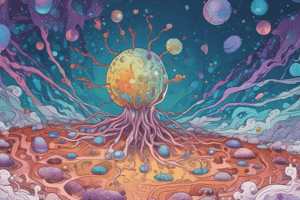Podcast
Questions and Answers
What are autoimmune diseases characterized by?
What are autoimmune diseases characterized by?
- Reactions of self molecules causing prolonged immune responses
- Reactions of host cells causing chronic inflammation (correct)
- Reactions of harmless foreign antigens causing tissue damage
- Reactions of foreign antigens causing acute inflammation
What is the basis of nonreactivity in the immune system?
What is the basis of nonreactivity in the immune system?
- Reacting to all infectious pathogens and cancers
- Not responding to self molecules or harmless foreign antigens (correct)
- Mounting damaging reactions against self structures
- Causing chronic inflammation in response to common environmental substances
What are some successful treatments for chronic inflammatory diseases targeted to?
What are some successful treatments for chronic inflammatory diseases targeted to?
- Components of the immune response (correct)
- Host cell reactions causing tissue damage
- Elimination of inciting antigens
- Prolonged inflammation in autoimmune diseases
In COVID-19, what contributes significantly to morbidity?
In COVID-19, what contributes significantly to morbidity?
Which type of immunity is always present in healthy individuals?
Which type of immunity is always present in healthy individuals?
What is the term used to describe the phenomenon of immunologic memory?
What is the term used to describe the phenomenon of immunologic memory?
Which component of the immune system provides the initial defense against infections?
Which component of the immune system provides the initial defense against infections?
Which type of cells are responsible for eradicating intracellular microbes?
Which type of cells are responsible for eradicating intracellular microbes?
Which type of immunity requires proliferation and differentiation of lymphocytes in response to microbes?
Which type of immunity requires proliferation and differentiation of lymphocytes in response to microbes?
Which type of cells are activated immediately after infection and before 12 hours as part of innate immunity?
Which type of cells are activated immediately after infection and before 12 hours as part of innate immunity?
Which immune response takes a few days to develop?
Which immune response takes a few days to develop?
What is the term used to describe the enhanced responses seen upon repeat exposures to the same microbe?
What is the term used to describe the enhanced responses seen upon repeat exposures to the same microbe?
Which cells and molecules recognize a limited number of molecular structures shared by classes of microbes?
Which cells and molecules recognize a limited number of molecular structures shared by classes of microbes?
What is required to initiate adaptive immune responses against infectious agents?
What is required to initiate adaptive immune responses against infectious agents?
Which type of cells lead to the formation of effector T cells after day 3 as part of adaptive immunity?
Which type of cells lead to the formation of effector T cells after day 3 as part of adaptive immunity?
Which type of molecules produced by microbes and noninfectious molecules are specifically recognized by lymphocytes or antibodies?
Which type of molecules produced by microbes and noninfectious molecules are specifically recognized by lymphocytes or antibodies?
Flashcards are hidden until you start studying
Study Notes
Autoimmune Diseases and Immune System
- Autoimmune diseases are characterized by an immune response against the body's own tissues and cells.
Immune System Basics
- The basis of nonreactivity in the immune system is tolerance, which prevents the immune system from reacting to the body's own tissues and cells.
Chronic Inflammatory Diseases
- Successful treatments for chronic inflammatory diseases are targeted to specific components of the immune system, such as cytokines, chemokines, and immune cells.
COVID-19
- Cytokine storm, which is an overactive immune response, contributes significantly to morbidity in COVID-19.
Types of Immunity
- Innate immunity is always present in healthy individuals and provides the first line of defense against infections.
- Adaptive immunity, on the other hand, requires proliferation and differentiation of lymphocytes in response to microbes.
Immunologic Memory
- The term used to describe the phenomenon of immunologic memory is anamnestic response.
Initial Defense Against Infections
- The innate immune system, which includes physical and chemical barriers, provides the initial defense against infections.
Eradicating Intracellular Microbes
- Cytotoxic T cells and macrophages are responsible for eradicating intracellular microbes.
Innate Immunity
- Neutrophils and natural killer cells are activated immediately after infection and before 12 hours as part of innate immunity.
Adaptive Immunity
- The adaptive immune response takes a few days to develop.
Enhanced Responses
- The term used to describe the enhanced responses seen upon repeat exposures to the same microbe is anamnestic response.
Recognition of Microbes
- Pattern recognition receptors (PRRs) recognize a limited number of molecular structures shared by classes of microbes.
Adaptive Immune Responses
- Recognition of pathogen-associated molecular patterns (PAMPs) by PRRs is required to initiate adaptive immune responses against infectious agents.
Effector T Cells
- Naive T cells lead to the formation of effector T cells after day 3 as part of adaptive immunity.
Antigens
- Antigens are molecules produced by microbes and noninfectious molecules that are specifically recognized by lymphocytes or antibodies.
Studying That Suits You
Use AI to generate personalized quizzes and flashcards to suit your learning preferences.



